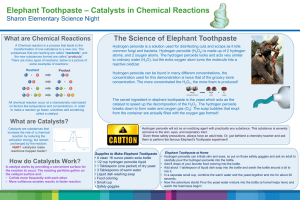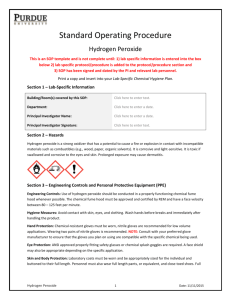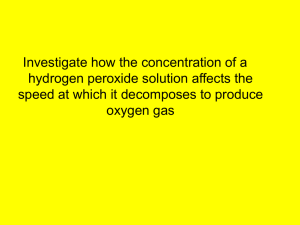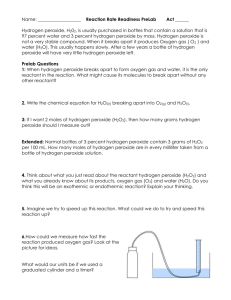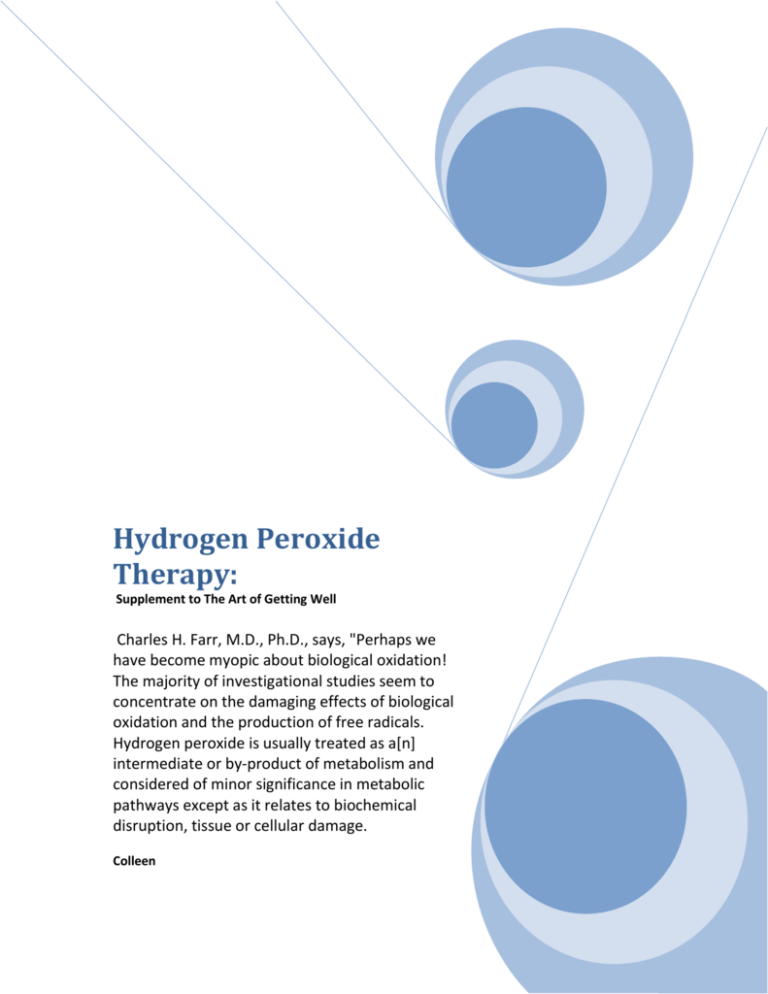
Hydrogen Peroxide
Therapy:
Supplement to The Art of Getting Well
Charles H. Farr, M.D., Ph.D., says, "Perhaps we
have become myopic about biological oxidation!
The majority of investigational studies seem to
concentrate on the damaging effects of biological
oxidation and the production of free radicals.
Hydrogen peroxide is usually treated as a[n]
intermediate or by-product of metabolism and
considered of minor significance in metabolic
pathways except as it relates to biochemical
disruption, tissue or cellular damage.
Colleen
Hydrogen Peroxide Therapy:
"Medical data is for informational purposes only. You should always consult your family
physician, or one of our referral physicians prior to treatment" - The Arthritis Trust of America.
Sources are given in references.
Authors of contributions\quotations are alphabetically arranged; major author, if any, is
underlined.
Charles Farr, M.D., Ph.D., William Campbell Douglass, M.D., Walter O. Grotz, Dr. Edward
Rosenow /Responsible editor/writer Anthony di Fabio.
Copyright 1992
All rights reserved by The Roger Wyburn-Mason and Jack M. Blount Foundation for the
Eradication of Rheumatoid Disease
AKA The Arthritis Trust of America,
7111 Sweetgum Road, Suite A, Fairview, TN 37062-9384
I must report on this promising therapy, as so many physicians and patients have
given me good tidings from its use. What is probably not so well known by the
general public, and many practicing physicians, is that hydrogen peroxide has been
used for more than a century, the abstracts of articles published from 1966 through
1988 alone reaches 2" high when printed on 8-1/2"X11" paper.
A number of clinics in the United States and Mexico use hydrogen peroxide therapy,
as well as other treatment modalities, on a routine basis, usually given by intravenous
injection (IV).
Before scoffing, keep in mind that one of the very first lines of defense against any
and all microorganisms recognized as invaders by our immunological system are
macrophages and leucocytes, one of which uses hydrogen peroxide to oxidize the
foreigners; and that vitamin C is effective principally by its ability to promote
hydrogen peroxide use against foreign invaders, including parasites, viruses, bacteria,
yeast/fungus; and that all body tissues contain catalase and that hydrogen peroxide in
the presence of catalase is reduced to oxygen and water. So, there is strong reason to
believe that added hydrogen peroxide, used properly, may be both effective against
certain organisms and safe.
Hydrogen peroxide is an essential metabolite, meaning that it is necessary to life's
process, according to William Campbell Douglass, M.D. of Georgia.
2
As we age, our immunological system weakens, which permits organisms of
opportunity to spread, thereby breeding colonies of organisms whose presence is
anathema to good health. Killing these organisms should permit at least temporary
respite from microbial warfare, and give your system time to heal.
According to William Campbell Douglass, M.D.2, not only is H2O2 (Hydrogen
Peroxide) involved in phagocytosis (killing and absorption of foreign germs), but
also "it acts like insulin in that it aids the transport of sugar through the body." Is is
also at least as important, or perhaps more so, than thyroid for heat generation
because it creates "intraceullar thermogenesis, a warming of your cells which is
absolutely essential to life's processes."
Various physicians, including some of our referral physicians, also use hydrogen
peroxide therapy for various ailments. Physicians have independently discovered
such treatments to be effective against some types of cancer, leukemia, arthritis,
coronary heart disease, arterial circulation disorders, colitis, gum diseases, and
assorted children's diseases.
The First International Conference of Bio-oxidative Medicine was held February 1719, 1989 in Dallas/Ft. Worth, TX. Physicians presented papers on the efficacy and
safety of hydrogen peroxide infusions. Since that date the non-profit International
Bio-Oxidative Medicine Foundation1 has grown rapidly, attracting many physicians
who have also presented many scholarly works based on their work with patients.
While Chelation Therapy is an extremely useful treatment and preventive measure
for at least 80% of peripheral circulation problems, it apparently cannot clean out
hardened plaque in arteries, like the large heart arteries and the aorta3.
According to Douglas, the Baylor University Medical Center may "have gone a long
way toward proving that H2O2 dripped into the leg and carotid vessels of patients
known to have severe arteriosclerosis will clear those arteries of disease. When these
patients died, autopsies were done to compare arteries that had been treated with
H2O2 with those not treated. They reported: `The elution [separation] of lipids from
the arterial wall by dilute hydrogen peroxide has been accomplished. . . .' In simple
English that means the plaque buildup was removed by injecting H2O2 into the
blood vessels. . . . That was over 20 years ago2."
Dr. Douglass added that, "The investigators also reported that the improvement is not
temporary."
While H2O2 has been used to good advantage for hardening of the arteries, temporal
arteritis, shingles, chronic obstructive pulmonary disease, the yeast syndrome,
3
various viral infections, including AIDS, certain forms of cancer, dental gum
diseases, colds (35% H2O2 in cold humidifier), growing better food, purifying water
without chlorine complications, increasing thyroid activity, arthritis, depression,
emphysema, lupus erythematosis, multiple sclerosis, . . ., a list of claims made would
exceed our space limitations, and so I direct you to others for substantiation and
research reports: The International Bio-Oxidative Foundation1 and ECHOS4, as per
references.
A word of caution: while many reputable physicians and researchers have made
legitimate claims on the safety and efficacy of H2O2 , it is my opinion that there are
a lot of scam artists using or selling H2O2 , and so one must be careful12. I believe
that you can rely on the work of the International Bio-Oxidative Medicine
Foundation and ECHOS.
There are also many important forgotten facts in the past medical literature. For
example, William Campbell Douglass, M.D. reports on "Dr. Edward C. Rosenow,
author of 450 published medical papers and associate at the Mayo Clinic for over 60
years . . . proved [more than] 70 years ago (1914) that bacteria could be found
consistently in the lymph nodes that drain joints (J.A.M.A., April 11, 1914). He was
probably the first scientist to postulate that H2O2 would help arthritis because of its
ability to supply oxygen to oxygen-hating organisms causing arthritis (Streptococcus
viridans)."
Charles H. Farr, M.D., Ph.D., says, "Perhaps we have become myopic about
biological oxidation! The majority of investigational studies seem to concentrate on
the damaging effects of biological oxidation and the production of free radicals.
Hydrogen peroxide is usually treated as a[n] intermediate or by-product of
metabolism and considered of minor significance in metabolic pathways except as it
relates to biochemical disruption, tissue or cellular damage.
We feel the physiological effects of bio-oxidation and, in particular hydrogen
peroxide, should be investigated with a new prospect.
From the 2,500 or more references on hydrogen peroxide we have collected and
reviewed we have come to appreciate this physiological product as a[n] extremely
important molecule in metabolism. Hydrogen peroxide is produced by all cells of the
body for many different physiological reasons. The granulocytes produce H2O2 as a
first line of defense against bacteria, yeast, virus, parasites, macrophages, and most
fungi. It is involved in any metabolic pathway which utilize oxidases, peroxidases,
cyclo-oxygenase, lipoxygenase, myeloperoxidase, catalase and probably many other
enzymes. Hydrogen peroxide is involved in protein, carbohydrate and fat
4
metabolism, immunity, vitamin and mineral metabolism or any other system you
might wish to explore.
Our studies demonstrate a positive metabolic effect to intravenous infusion of H2O2
. Its ability to oxidize almost any physiological or pathological substance, in addition
to producing increased tissue and cellular oxygen tensions, has proven it to have
therapeutic value.
"We feel the evidence presented should stimulate a new appreciation in the study of
the potential therapeutic application of bio-oxidative mechanisms."
Two Means of Administration
There are two ways to administer hydrogen peroxide for medical purposes. Both
means require a pure grade of hydrogen peroxide which is something different than
one can purchase at the drug store for topical treatment of sores and wounds. The 3%
drugstore hydrogen peroxide also contains tin and phosphate compounds that are
dangerous to consume either by means of IV (intravenous) or orally.
For sources of pure "food grade" oral or intravenous hydrogen peroxide, contact
ECHO4.
I must caution at the outset that Dr. Farr and some other physicians11 do not approve
of use of H2O2 for oral treatment, as so many treatment modalities describe11. The
exact method for oral administration can also be obtained from ECHO.
Dr.Farr, and some other physicians, feel that free-radicals are produced in the
stomach when H2O2 is administered orally, and these free-radicals are not safe.
Combinations of fatty acids which are likely to be in the stomach in the presence of
iron and ascorbate may reduce hydrogen peroxide to hydroxyl and superoxide free
radicals. These may have a deleterious effect upon the gastric and duodonal mucosa,
with an increase of glandular stomach erosion, duodonal hyperplasia (abnormal
increase in number of cells), adenoma and carcinoma, although in rats there seems to
be inconsistencies in the studies related to carcinogenesis using 0.8% concentration
for ten weeks versus 1% concentration for 32 weeks, the former indicating
carcinogensis, the latter not so.
Since some clinics are using both intravenous and oral techniques with patients
successfully, or to some good advantage, apparently not all possible research is in on
the subject of oral versus IV administration.
5
I have twice tried the oral method, and have failed to continue onward, because of a
terrible, revolting nausea. Some folks react similarly, others don't, and some
persevere despite all.
As stated earlier, Dr. Farr's research demonstrates that hydrogen peroxide stimulates
oxidative enzymes which increases the metabolic rate. Intravenous use rapidly
relieves allergenic reactions, influenzal symptoms, chronic systemic candidiasis,
acute viral reactions as a result of the oxidation of antigenic substances and
regulation of immune system functions.
To prepare the IV (intravenous) solutions, Dr. Farr begins with 30% H2O2 of USP
food or cosmetic grade. Thirty percent H2O2 is a powerful oxidizer and should be
handled with extreme caution.
The 30% solution is diluted with equal amounts of sterile distilled water to make a
15% stock solution. The stock solution is passed through a Millipore 0.22mm
medium flow filter for sterilization and removal of particulate matter. The stock
solution is stored in 100 ml sterile containers and kept refrigerated for future use.
His infusion solutions are then prepared using sterile 5% dextrose in water. The
addition of 1/4 ml sterile of the 15% H2O2 stock solution to each 100 ml of carrier
solution produces a 0.0375% concentration that is finally used for the intravenous
infusions.
Dr. Farr further warns that "caution must be exercised that nothing is added to the
H2O2 solution because of its tremendous oxidizing power. Even ascorbic acid
(Vitamin C) is rapidly oxidized to the mono-dehydroascorbate radical, an unstable
compound which degrades into numerous other chemical fragments. . . . Vitamins,
minerals, peptides, enzymes, amino acids, heparin, EDTA, or other injectable
materials should never be mixed with the H2O2 solution."
By far the widest use for hydrogen peroxide, whether wisely or not, seems to be that
of oral use, where a 35% "food grade" is diluted to a 3% concentration by use of 1
ounce of 35% H2O2 to 11 ounces of distilled water. The 3% concentration is then
used by quantities of drops in distilled water, increasing the dosages and number of
oral treatments daily throughout a number of weeks.
Many have made the claim that a "die-off" effect is observed, similar in nature to the
Herxheimer Effect5.
Further information on the oral use of H2O2 may be acquired from ECHO4.
6
There are many other uses for hydrogen peroxide for health purposes than simply
topical use on sores, or intravenous therapy. With permission from ECHO4, the
following is presented:
Other Uses for H2O2
Use 3% solution, except where 35% is highlighted.
Vegetable soak: Add 1/4 cup to a full sink of cold water. Soak light-skinned (like
lettuce) 20 minutes, thicker skinned (like cucumbers) 30 minutes. Drain, dry and
refrigerate. Prolongs freshness. If time is a problem, spray vegetables (and fruits)
with a solution of 3%. Let stand for a few minutes, rinse and dry.
Leftover tossed salad: Spray with a solution of 1/2 cup water and 1 Tbsp. 3%. Drain,
cover and refrigerate.
To freshen kitchen: Keep a spray bottle in the kitchen. Use it to wipe off counter tops
and appliances. It will disinfect and give the kitchen a fresh smell. Works great in the
refrigerator and kid's school lunch boxes.
Marinade: Place meat, fish, or poultry in a casserole (avoid using aluminum pans).
Cover with hydrogen peroxide. Place loosely covered in refrigerator for 1/2 hour.
Rinse and cook.
In the dishwasher: Add 2 ozs to your regular washing formula.
Sprouting seeds: Add 1 oz. to a pint of water and soak the seeds overnight. Add the
same amount of hydrogen peroxide each time you rinse the seeds.
House and garden plants: Put 1 oz. in 1 quart of water. Water or mist plants with this
solution.
House and garden plants: Put 1 oz. in 1 quart of water. Water or mist plants with this
solution.
Insecticide spray: Mix 8 ozs. white sugar, 4-8 ozs. hydrogen peroxide in 1 gallon of
water.
Humidifiers and steamers: Mix 1 pint to 1 gallon of water.
Laundry: Add 8 ozs. to your wash in place of bleaches.
7
Shower: Keep a spray bottle of hydrogen peroxide in the shower. Spray your body
after washing to replace the acid mantle of your skin that soap removes.
Facial: Use on a cotton ball as a facial freshener after washing. (Remember: do not
use 35% grade!)
Rejuvenating detoxifying bath: Add 6 ozs. to 1/2 tub of water. May increase
hydrogen peroxide up to 2 cups per bath. Soak at least 1/2 hour.
Alternate bath: Add 1/2 cup 35% H2O2 , 1/2 cup sea salt, and 1/2 cup baking soda or
epsom salts to bath water and soak.
Foot soak: Add 1-1/2 ozs. 35% H2O2 to 1 gallon water and soak.
Athlete's foot: Soak feet nightly until condition is improved.
Mouthwash: Add a dash of liquid chlorophyll for flavoring if desired.
Toothpaste: Use baking soda and add enough to make a paste. Or just dip your brush
in it and brush.
Douche or enema: Add 6 Tbls. to a quart of distilled water. 6 Tbls. is the maximum
amount to use.
Pets: For small animals (dogs & cats) use 1 oz. to 1 qt. of water.
Agriculture: Use 8 ozs. 35% H2O2 per 1000 gallons of water. If you do not have an
injector, start out by using 1 tsp. 35% H2O2 in the drinking cup at the stanchion.
Drinking water of ailing cows: Use 1 pt., to 5 gallons of water. To drench sick calves,
put 1/3 pt. bottle and fill remainder with water. Do this twice a day. For an adult cow,
use the same procedure, but use a quart.
Foliage feed crops: put 5 to 16 ozs. of 35% H2O2 into 20 gallons of water. This is
sufficient for 1 acre. Spray on plants early in the morning when the dew is still on
them and the birds are singing.
Hydrogen peroxide has been a recognized medicinal source since at least the 1800's,
has gone into disrepute, and now seems to lie in a sort of limbo, so far as established
medicine is concerned.
8
However, research has progressed forward on its use throughout the world, and
American doctors of a more open-minded view are persisting in learning its good
effects.
Again I caution the reader that there is controversy between the use of oral hydrogen
peroxide and use of IV (intravenous) treatment. You must study the issues and come
to your own judgement. But please make an educated decision, and whichever you
decide, find a physician who knows what he/she is doing.
Stimulation of Oxidative Enzymes
Charles H. Farr, M.D., Ph.D. has used hydrogen peroxide clinically, and has reported
on research that he performed that sheds a great deal of light on how H2O2
functions. Contrary to popular belief, the use of H2O2 by either infusion or orally
cannot supply as much oxygen as a good, deep breath. Instead, it is the stimulation of
oxidative enzymes that does the useful trick. Dr. Farr's conclusions are appropriate
and follow:
Dr. Farr says6, "There are a number of commercial products [that] claim to contain
more oxygen on a volumes percent basis than Hydrogen Peroxide and consequently
this has been interpreted as meaning they would somehow have more biological
activity. There is a great deal of confusion about the difference between the terms
`Oxygenation' and `Oxidation' when applied to biochemical reactions. A product
which contains more oxygen per molecule may or may not have any biological
activity.
"We reported1 Intravenous Hydrogen Peroxide has an oxidative stimulatory effect
when administered to man which appears to be independent of the amount of oxygen
produced.
"Hydrogen Peroxide is a very simple molecule produced by almost every cell in the
body. This amazing molecule, essential for life in both plant and animal, has been
generally overlooked for it's role in oxidative metabolism. Every chemist knows any
reaction must have an opposite reaction to balance the equation. This applies equally
to reactions in the test tube and in living cells. The world seems to have been caught
up in the idea all biological oxidation is harmful because free-radicals may be
produced. Free-radicals can cause lipid peroxidation and membrane damage.
Consequently many products, containing anti-oxidants, are being promoted to
prevent peroxidation. Some researchers7, including this author, feel peroxidation
serves a useful purpose in the biochemical balance and may need stimulating at times
instead of preventing.
9
"Hydrogen Peroxide as an oxidizer, under certain catalytic conditions, can degrade
into water and oxygen.
"The fact that Hydrogen Peroxide may increase oxygen tension in the tissue is of
secondary importance. Any student of biochemistry knows the principal reaction of
an oxidizer, such as Hydrogen Peroxide, is to accept electrons in the RedOx
[reduction/oxidation] reactions of the body and has nothing to do with "Oxygen" or
"Oxygenation." It is true Hydrogen Peroxide increases the rate of oxidation in the
body8, but this is not because it produces oxygen but rather it stimulates oxidative
enzymes.
"Hydrogen Peroxide is a naturally produced purposeful molecule in the body. It
functions to aid membrane transport, acts as a hormonal messenger, regulates
thermogenesis (heat production), stimulates and regulates immune functions,
regulates energy production and many other important metabolic functions. These
effects can occur without increasing the amount of oxygen. It is purposely used by
the body to produce Hydroxyl Radicals to kill bacteria, virus, fungi, yeast and a
number of parasites. This natural killing or protective system has nothing to do with
increasing the amount of available oxygen.
"The amount of oxygen produced by a therapeutic infusion of Hydrogen Peroxide is
very small. A single breath of fresh air contains many times more oxygen than found
in either a therapeutic infusion or in a few drops of 35% Food Grade Hydrogen
Peroxide taken orally.
"Claims are being made that molecules containing Oxygen and Chlorine, Chlorine or
Chlorite ions will sterilize water, milk and almost anything to which they have been
added. Chlorine is added to almost all public water supplies for the same purpose.
The small amount of oxygen in these molecules have very little to do with this
sterilization process. There are many more aerobic (requires oxygen) than anerobic
(does not use oxygen) bacteria and increasing the oxygen supply may actually
stimulate the growth of the aerobic bacteria. `Oxygen supply' or `Oxygenation' is not
a credible basis for the promotion of these products. Oxidation is the key word and
not Oxygenation.
"Oxidation is the removal of an electron from a molecule which changes electrical
energy of the molecule into an oxidized state. The oxidizing agent which accepts the
electron through this reaction becomes reduced. This reaction takes place in many
biochemical reactions in which OXYGEN is not involved. In oxidative reactions in
which Hydrogen Peroxide is involved, oxygen is released when the Hydrogen
Peroxide, acting as an oxidizer, is reduced but it is the transfer of the electrons which
is important and not the production of Oxygen.
10
"Manufacturers of products which claim to have the same effect as Hydrogen
Peroxide may not have a good understanding of the biochemical role of Hydrogen
Peroxide in the body. Some of these products claim to provide more oxygen
molecules than Hydrogen Peroxide and that may be true but I know of no scientific
evidence to show this enhances oxidative metabolism. Cancer and many other
degenerative diseases are thought to be the results of poor cellular oxidative
processes. They are not the results of a reduced supply of oxygen. Persons with
anemias or severe lung disease may have an oxygen deficit but do not necessarily
have a greater incidence of Cancer or chronic diseases. The problem is not the
delivery of oxygen to the cells but utilization by the cells. Hydrogen Peroxide affects
utilization or oxidation dramatically whereas hyper-oxygenated or chlorinated
molecules have not been shown to be necessary in the body to improve oxidative
metabolism9."
Many physicians and clinics are effectively using Hydrogen Peroxide intravenously
with their patients.
There is a ton of literature favoring Hydrogen Peroxide treatment for various medical
conditions10.
We suggest that your study of H2O2 may be an important step in your search for
good health. It's worth looking into!
References
1. International Bio-Oxidative Medicine Foundation, PO Box 13205, Oklahoma City, OK 73113-1205.
2. William Campbell Douglass, The Cutting Edge, PO Box 1568, Clayton, GA 30525. According to Douglass'
paper, see: Docknell, Inf./Immunity, January 1983, pp. 456; Mallams, Finney & Balla, S.M.J., March 1962; Jay et.
al., Tex Rep. Biol. & Med., 22:106, 1964; Urschel, Diseases of the Chest, 51:180, 1967; Finney, et. al., Angiology,
17:223, 1966; Hydrogen Peroxide -- The Forgotten Miracle.
3. Anthony di Fabio, Chelation Therapy, The Arthritis Trust of America/The Rheumatoid Disease Foundation,
7111 Sweetgum Road, Suite A, Fairview, Tn 37062-9384.
4. Walter O. Grotz, ECHO, 300 South 4th Street, Delano, MN 55328. ECHO for a small fee can provide you with a
listing of abstracts dating back to 1920; also see their Progress Report, 2nd Edition.
5. Dr. Paul K. Pybus, Anthony di Fabio, The Herxheimer Effect, The Arthritis Trust of America/The Rheumatoid
Disease Foundation, 7111 Sweetgum Road, Suite A, Fairview, Tn 37062-9384.
6. Charles H. Farr, M.D., Ph.D., The Therapeutic Use of Intravenous Hydrogen Peroxide (Monograph). Genesis
Medical Center, Oklahoma City, OK 73139, Jan. 1987.
7. T.L. Dormandy, "In Praise of Peroxidation," Lancet, II (Nov. 12):1126, 1988.
11
8. Charles H. Farr, M.D., Ph.D., "Physiological and Biochemical Responses to Intravenous Hydrogen Peroxide in
Man," J ACAM, 1:113-129, 1988.
9. "Why Hydrogen Peroxide?" International Bio-Oxidative Medical Foundation Newsletter, Vol. II, No. 1, Op.Cit.,
1989.
10. Ed McCabe, O2xygen Therapies, Energy Publications, 99-RD1, Morrisville, NY 13408, 1988.
11. Leon Chaitow, "Bland Attacks `Fad' for Hydrogen Peroxide," Townsend Letter for Doctors," May 1988, p.
204; from Journal of Alternative & Complementary Medicine (UK).
12. Jonathan Collin, M.D., "The H2O2 Crusades," Townsend Letter for Doctors, Op.Cit., June 1989,
12





